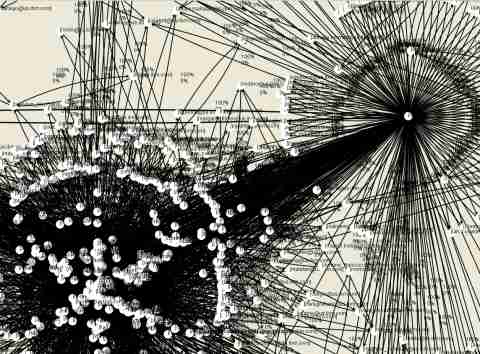As part of my day job I work in a team looking at Business Innovation and Optimization. The short version of this is that if you use Websphere Modeller to create your business processes, Websphere Monitor to put instrumentation into those processes and then deploy it all on Websphere Process Server, you get in the position where you can use business dashboards to see what is going on in the business. IT and Business management become holistic and role based views of the active system let people have the control they need. Once you have all this instrumentation, you can then analyze what is happening, and fix it. We have the concept of On Demand, and this really is.
As part of this work I was looking at how to make better use of Geographic Information Systems (GIS) and how to place business data and information onto those in real time. One of the leaders in GIS is esri.com. They have recently created a set of public web services to allow access to some fo the power of GIS. I have spent a few days putting thigs together, JSPs, WSDL generation to code in order to prove that we can hook the results of Websphere Monitor up with GIS.
The initial examples I looked at were just around getting existing maps, quakes, satellite images etc. However I soon came across the getThematicMapImage. This allows me to make a request of a web service having provided some data to associate with each geographic unit. ESRI then generate, on the fly, a colour coded map. It worked really well, and proved that my code was able to be in control of the numeric data whilst the web service was in control of the complicated geogrphic information. In the example I used US States as that was handy and easy, the rest of my team are over in the US as well.
arcwebonline has some live running samples and the sort of thing that can be done with the web service.
There are lots of other suppliers and it just so happens I went down this route as one avenue to investigate. Web services, whilst a little tricky with versions of generators, certainly helped me prove what I needed to do.
Ian Hughes (Consulting IT Specialist Emerging Technologies, IBM Hursley)






 (not pretty but we only had 10×10) on the million dollar homepage. Look down from the first i in million on the logo at the top, about 6 rows down, and there we are. Does this page work? Well I could not resist clicking on the “Even monkeys fall from trees” link and I made a purchase, but maybe it shows I am gullable. A pre-req for being an early adopter?
(not pretty but we only had 10×10) on the million dollar homepage. Look down from the first i in million on the logo at the top, about 6 rows down, and there we are. Does this page work? Well I could not resist clicking on the “Even monkeys fall from trees” link and I made a purchase, but maybe it shows I am gullable. A pre-req for being an early adopter?